
What Is Canyon Bathing? (And Why Am I Obsessed With It?)
Yes, canyon bathing is a thing™, and I will never stop doing it.
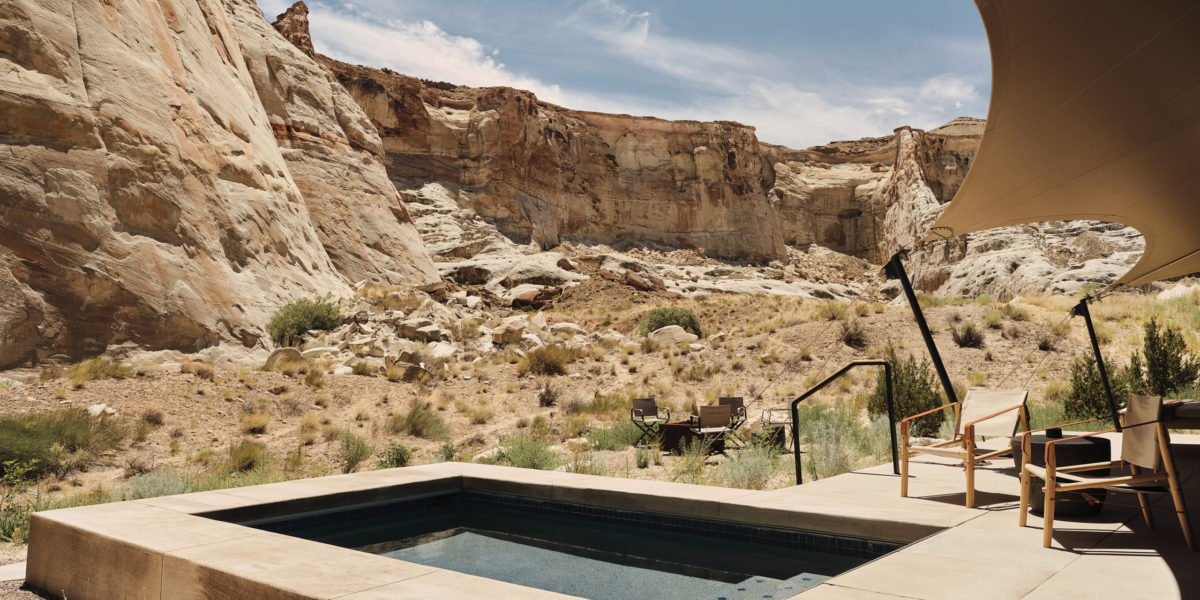
Courtesy of Amangiri
There’s a wellness trend sweeping the world called forest bathing, in which you immerse yourself in the woods and the trees—no real destination in mind—to de-stress and unwind. The concept originated in Japan, where it is called shinrin-yoku. If you take the time to tune into Mother Nature in this way, experts say, it can be incredibly relaxing.
Today is not that day.
Instead, it’s a warm evening in Arizona when I mosey up a dirt trail flanked by towering saguaros, finding myself lured by the smells of minerals emanating from a hot spring up ahead. The sun has just dropped behind the Bradshaw Mountains as I arrive at the edge of the pool, sling my towel over a boulder, and carefully dip one foot into the water, which clocks in at about 106 degrees.
This serene, turquoise oasis is one of three at Castle Hot Springs, a historic resort about an hour north of Phoenix where you’re more likely to see a kaleidoscope of butterflies speed by than a car. A recent multi-year renovation transformed the remote 1896 property—seriously, it’s a dusty, winding drive off the highway—into the contemporary wellness destination it is today.
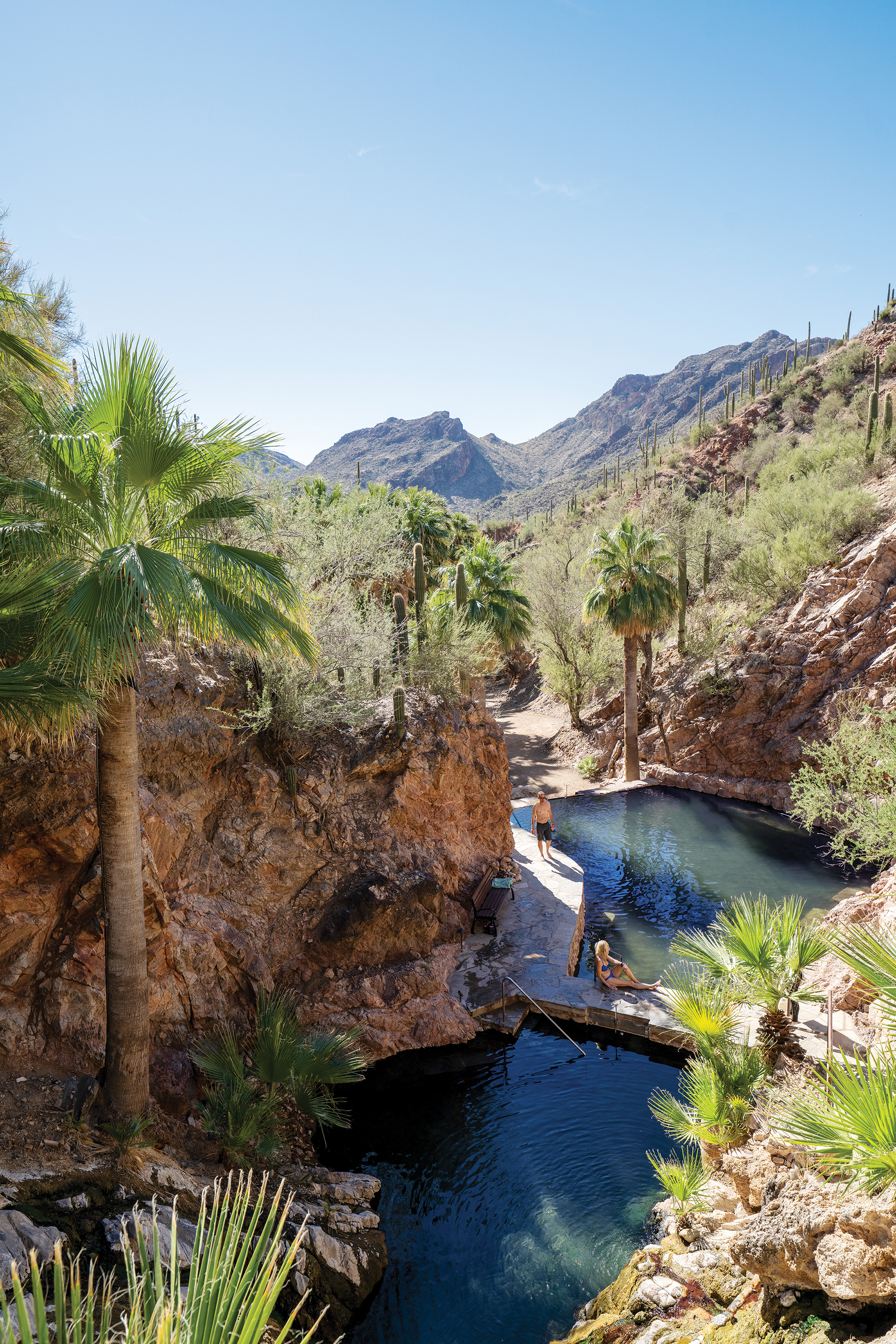
Thomas J. Story
With century-old palm trees and even older cacti perched stoically above me, I descend into the pool and wade up to my chin, the heat moving through my body in a slow swell that starts deep in my stomach before rising to my cheeks. As I bob there, the adrenaline coursing its way straight through my forehead, my toes curl tight into the loose gravel beneath me.
Like a kettle on the cusp of a whistle, I breathe.
It’s the first time in months I’ve felt this type of rush in my body, one that ultimately moves through me instead of settling in with a familiar unease. Here in this hidden corner of the Sonoran Desert, I consider the idea that perhaps I should work more canyon bathing (yes, the desert version of forest bathing) into my wellness routine. At this point, I’m all ears for any grounding practice after the unpredictability of these past few years.
Listen, I, too, have reaped the benefits of forest bathing. I’ve soaked in a hot spring high above the tree line of the eastern Sierra, where bathing suits were optional and you could look out over dizzying rows of pines. I’ve hiked switchbacks in the far-flung reaches of Yosemite, breathless from the elevation gain and the intoxicating smell of the trees. Last summer, I meandered through redwoods that towered above me like centuries-old sentinels, making me feel both small and completely grounded at the same time.
But there’s just something about the desert.
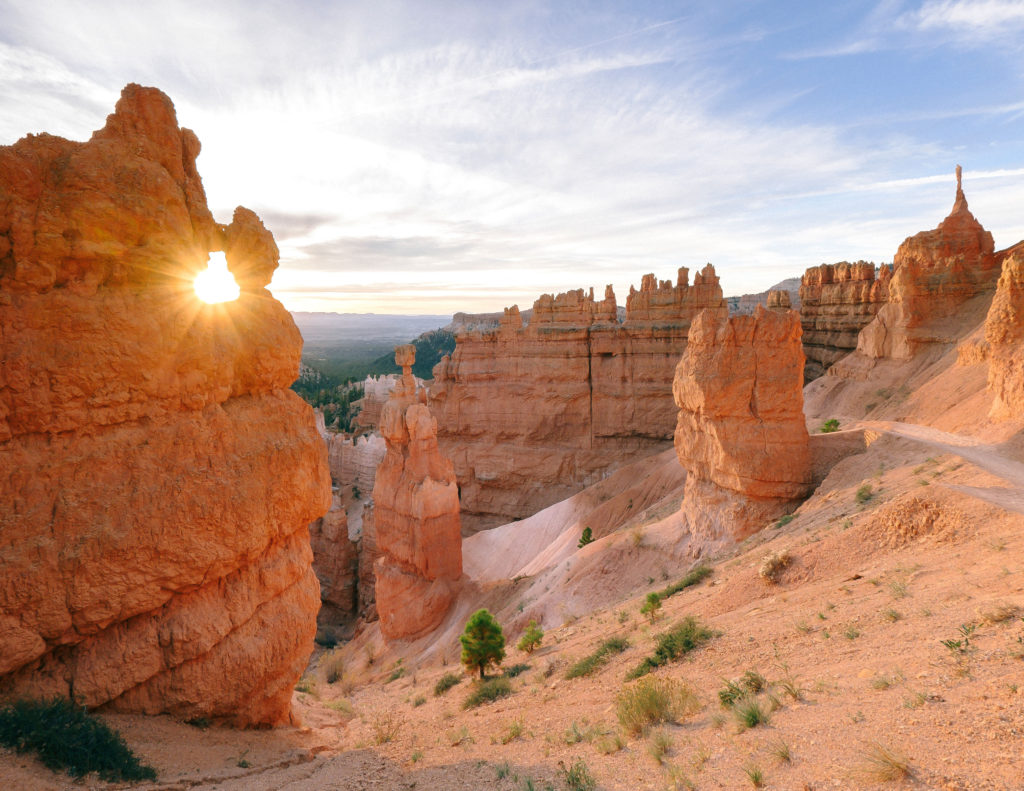
Thomas J. Story
It’s the way the stark, open landscape may look lifeless on the surface; but for those who look closer—and spend time soaking in its beauty—there’s a meditative experience to be discovered amid the abundance of life hidden in its cryptobiotic crust. Red rock mesas mesmerize with lines formed across millennia. Slot canyons carved by flood waters twist and turn their way through the dust.
So, I wondered: Do therapeutic nature spaces actually have to be green? Because I’ve found mental and emotional benefits amid the muted palette of the desert. And, as it turns out, I’m not the only one.
Seriously, What Is Canyon Bathing?
Merriam-Webster defines a canyon as a “deep narrow valley with steep sides and often with a stream flowing through it.” There are everything from slot canyons and box canyons to submarine canyons, all the way to one you might be familiar with—the Grand Canyon. I first heard the term “canyon bathing” from some team members at Castle Hot Springs, where the remote oasis offers an antithesis of sorts to forest bathing.
For me, “bathing” in these geological wonders can be both literal or figurative. In Anza-Borrego Desert State Park in Southern California, for example, I’ve descended dusty slot canyons that beckon adventurous explorers into their confines for a quiet, reflective journey into the heart of the landscape. In the Utah desert, ultra-luxe retreat Camp Sarika is surrounded by canyons; on the property, heated plunge pools boast views of the surrounding mesas for a down-to-earth, private soak.
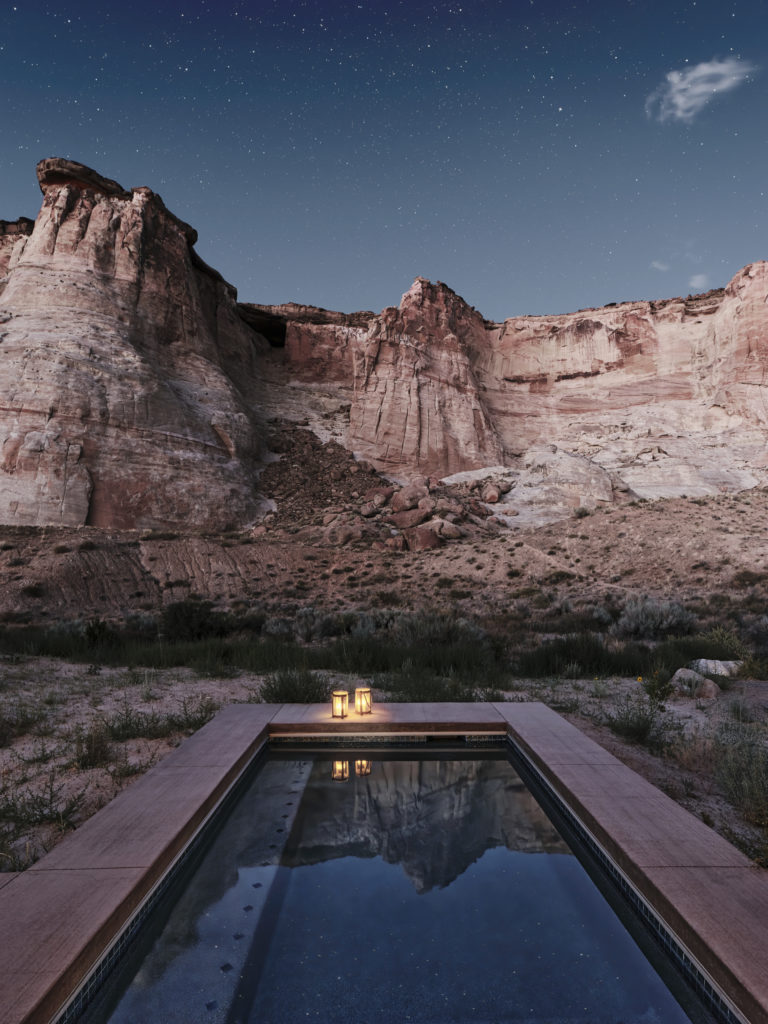
Courtesy of Amangiri
Justin Legge, the tour director and lead naturalist at Benbow Historic Inn amid the California redwoods, offers forest bathing tours to guests but has also led nature therapy walks amid the ocean and sandy dunes of nearby Humboldt.
“Green might be my favorite color, but to receive the mental benefits of nature therapy and nature immersion, green is not necessary,” Legge tells me.
Mental refreshment can happen in any natural area, Legge says, even without trees. “Our main focus is calming our overactive minds, relieving anxiety, relieving depression, and increasing contentment. These benefits come from a person engaging with nature in a more specific way, and can be achieved in any natural environment.”
There are differences, however. Trees have been shown to produce organic compounds with health benefits. “You can only receive the benefits of coniferous tree phytoncides by breathing in near them,” Legge says. “That is not possible, of course, in the desert without trees.”
Canyon Bathing Benefits
So, I might not be breathing in what Forest Bathing author Dr. Qing Li calls “wood essential oils” when I’m out in a desert canyon, but I sure as heck feel like I’m immersed in a sense of awe.
In Arizona, I remember quite nearly tiptoeing on through Antelope Canyon in Page—floored by the emotional experience of feeling its pink and orange sandstone walls swirl around me, bringing an inner peace only interrupted by a group of obnoxiously loud tourists.
In Southern California, the Mecca Hills Wilderness beckons with various slot canyons where trails require ladder climbs but the view is worth it. And in Palm Springs, fan palms create a shaded canopy alongside a bubbling stream in Indian Canyons, an oases apt for contemplation that’s located on Agua Caliente Band of Cahuilla Indians land.
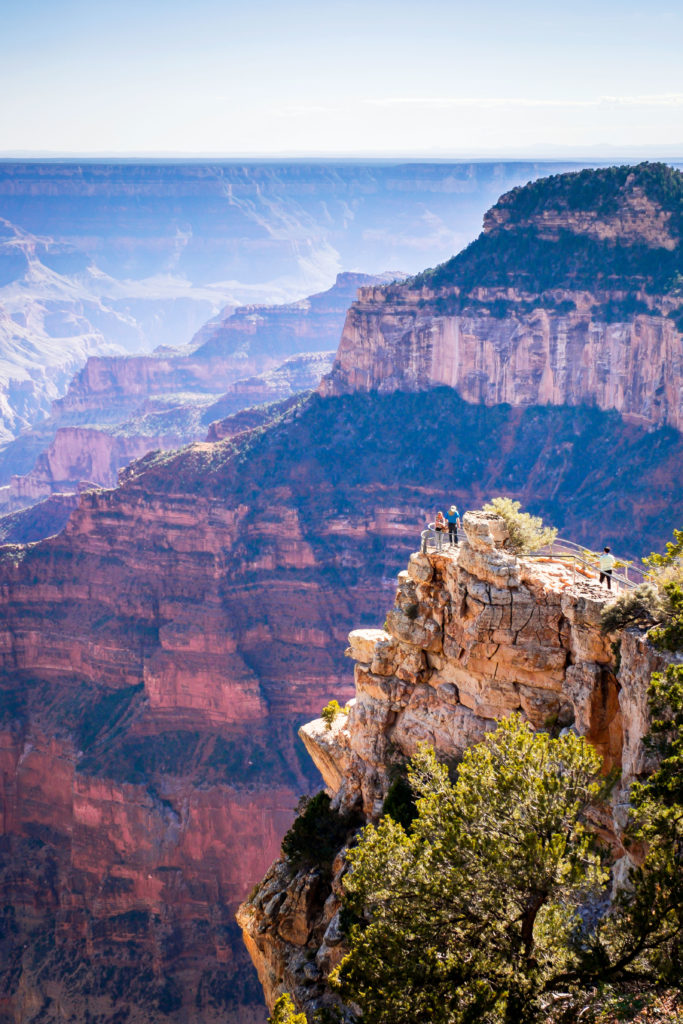
Thomas J. Story
“When you connect to nature on a deep level, you leave with a deeper appreciation, and understand the need to protect it,” says Susan Madden, a forest bathing guide who offers retreats and experiences in Central California. “That is particularly true in deserts. For me, it took spending quiet time in the desert to truly appreciate how much life existed there.”
Benjamin Page, author of Healing Trees: A Pocket Guide to Forest Bathing, says a big part of forest bathing that can easily be applied in any landscape or environment is simply the act of resting. “Nature helps us calm down our nervous systems, which can support us in shifting our bodies into a state of rest,” Page tells me. “When we rest, the body gets to work at healing itself, so if you feel relaxed in the canyons, this is just as good as anywhere else!
How Best to Canyon Bathe
So, how best to canyon bathe? For Legge, any type of nature immersion most importantly depends on sound—getting away from the rumble of cars, the buzzing of helicopters, and the list goes on. “Our minds are so used to the constant human buzz of sound, when we can actually get away from it, and experience the sounds of nature/silence purely, it can help reset our monkey minds.”
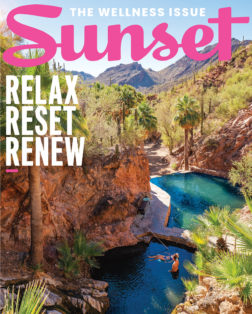
Sunset’s Wellness Issue 2022
More from this issue:
- How Seth Rogen Turned Meditative Practices into Houseplant’s Homewares
- Booze-Free Bars and Shops Are Finally Gaining Momentum in the West
- Warmer Weather Is Around the Corner: Your February and March Garden Checklist
- These Wellness Getaways Offer Next-Level Spots to Soak
- New Nostalgia Is on the Menu at Seattle’s Hottest Filipino Restaurant
The fact that canyons are often home to streams is a plus, too. Legge says focusing on a natural sound—like a bubbling brook, singing sands, birds chirping, et cetera—can help facilitate that break.
Second, Legge suggests finding some “awe.” It “doesn’t have to be epic and amazing, just something to focus on that has beauty to your mind’s eye.”
“I have found my best times are focusing up close on a tree trunk, or getting down on my knees and specifically trying to look at one grain of sand, and how its color is different from the other,” adds Legge, who carries a magnifying glass as a reminder to do this. “What we are trying to do is get our mind to focus on the present moment using our sensory experiences.”
Finally, slow down! Legge finds most people’s main barrier to receiving nature’s benefits is “trying to accomplish too much.” You “don’t need to get to the end of the trail,” Legge adds, “or the top of the mountain. In fact, you don’t need to get anywhere!” Pick one spot, and allow yourself to be immersed in the moment.
Then, “move super-duper slow,” Legge says. If this is difficult, find a guide to hold that space for you.
Next up on my bucket list? Cathedral Gorge State Park in Nevada. Canyon de Chelly National Monument in Arizona. And California’s Walker Canyon Ecological Reserve during a poppy bloom. In a few weeks, I’ll head to southern Utah for this very purpose—to take in the beauty of Zion and Bryce Canyon national parks in all their glory. I’ll turn off my cellphone, pack some snacks in my Osprey, and find a remote trail to explore.
Then, I’ll take a second to pause. And I’ll breathe.
